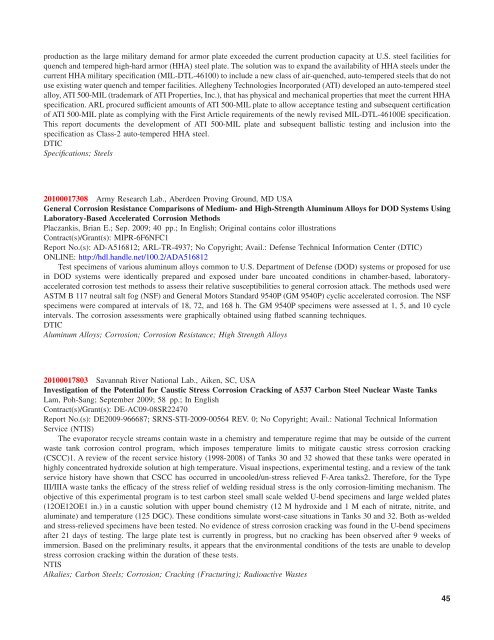NASA Scientific and Technical Aerospace Reports - The University ...
NASA Scientific and Technical Aerospace Reports - The University ...
NASA Scientific and Technical Aerospace Reports - The University ...
Create successful ePaper yourself
Turn your PDF publications into a flip-book with our unique Google optimized e-Paper software.
production as the large military dem<strong>and</strong> for armor plate exceeded the current production capacity at U.S. steel facilities for<br />
quench <strong>and</strong> tempered high-hard armor (HHA) steel plate. <strong>The</strong> solution was to exp<strong>and</strong> the availability of HHA steels under the<br />
current HHA military specification (MIL-DTL-46100) to include a new class of air-quenched, auto-tempered steels that do not<br />
use existing water quench <strong>and</strong> temper facilities. Allegheny Technologies Incorporated (ATI) developed an auto-tempered steel<br />
alloy, ATI 500-MIL (trademark of ATI Properties, Inc.), that has physical <strong>and</strong> mechanical properties that meet the current HHA<br />
specification. ARL procured sufficient amounts of ATI 500-MIL plate to allow acceptance testing <strong>and</strong> subsequent certification<br />
of ATI 500-MIL plate as complying with the First Article requirements of the newly revised MIL-DTL-46100E specification.<br />
This report documents the development of ATI 500-MIL plate <strong>and</strong> subsequent ballistic testing <strong>and</strong> inclusion into the<br />
specification as Class-2 auto-tempered HHA steel.<br />
DTIC<br />
Specifications; Steels<br />
20100017308 Army Research Lab., Aberdeen Proving Ground, MD USA<br />
General Corrosion Resistance Comparisons of Medium- <strong>and</strong> High-Strength Aluminum Alloys for DOD Systems Using<br />
Laboratory-Based Accelerated Corrosion Methods<br />
Placzankis, Brian E.; Sep. 2009; 40 pp.; In English; Original contains color illustrations<br />
Contract(s)/Grant(s): MIPR-6F6NFC1<br />
Report No.(s): AD-A516812; ARL-TR-4937; No Copyright; Avail.: Defense <strong>Technical</strong> Information Center (DTIC)<br />
ONLINE: http://hdl.h<strong>and</strong>le.net/100.2/ADA516812<br />
Test specimens of various aluminum alloys common to U.S. Department of Defense (DOD) systems or proposed for use<br />
in DOD systems were identically prepared <strong>and</strong> exposed under bare uncoated conditions in chamber-based, laboratoryaccelerated<br />
corrosion test methods to assess their relative susceptibilities to general corrosion attack. <strong>The</strong> methods used were<br />
ASTM B 117 neutral salt fog (NSF) <strong>and</strong> General Motors St<strong>and</strong>ard 9540P (GM 9540P) cyclic accelerated corrosion. <strong>The</strong> NSF<br />
specimens were compared at intervals of 18, 72, <strong>and</strong> 168 h. <strong>The</strong> GM 9540P specimens were assessed at 1, 5, <strong>and</strong> 10 cycle<br />
intervals. <strong>The</strong> corrosion assessments were graphically obtained using flatbed scanning techniques.<br />
DTIC<br />
Aluminum Alloys; Corrosion; Corrosion Resistance; High Strength Alloys<br />
20100017803 Savannah River National Lab., Aiken, SC, USA<br />
Investigation of the Potential for Caustic Stress Corrosion Cracking of A537 Carbon Steel Nuclear Waste Tanks<br />
Lam, Poh-Sang; September 2009; 58 pp.; In English<br />
Contract(s)/Grant(s): DE-AC09-08SR22470<br />
Report No.(s): DE2009-966687; SRNS-STI-2009-00564 REV. 0; No Copyright; Avail.: National <strong>Technical</strong> Information<br />
Service (NTIS)<br />
<strong>The</strong> evaporator recycle streams contain waste in a chemistry <strong>and</strong> temperature regime that may be outside of the current<br />
waste tank corrosion control program, which imposes temperature limits to mitigate caustic stress corrosion cracking<br />
(CSCC)1. A review of the recent service history (1998-2008) of Tanks 30 <strong>and</strong> 32 showed that these tanks were operated in<br />
highly concentrated hydroxide solution at high temperature. Visual inspections, experimental testing, <strong>and</strong> a review of the tank<br />
service history have shown that CSCC has occurred in uncooled/un-stress relieved F-Area tanks2. <strong>The</strong>refore, for the Type<br />
III/IIIA waste tanks the efficacy of the stress relief of welding residual stress is the only corrosion-limiting mechanism. <strong>The</strong><br />
objective of this experimental program is to test carbon steel small scale welded U-bend specimens <strong>and</strong> large welded plates<br />
(12OE12OE1 in.) in a caustic solution with upper bound chemistry (12 M hydroxide <strong>and</strong> 1 M each of nitrate, nitrite, <strong>and</strong><br />
aluminate) <strong>and</strong> temperature (125 DGC). <strong>The</strong>se conditions simulate worst-case situations in Tanks 30 <strong>and</strong> 32. Both as-welded<br />
<strong>and</strong> stress-relieved specimens have been tested. No evidence of stress corrosion cracking was found in the U-bend specimens<br />
after 21 days of testing. <strong>The</strong> large plate test is currently in progress, but no cracking has been observed after 9 weeks of<br />
immersion. Based on the preliminary results, it appears that the environmental conditions of the tests are unable to develop<br />
stress corrosion cracking within the duration of these tests.<br />
NTIS<br />
Alkalies; Carbon Steels; Corrosion; Cracking (Fracturing); Radioactive Wastes<br />
45

















